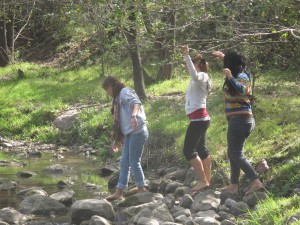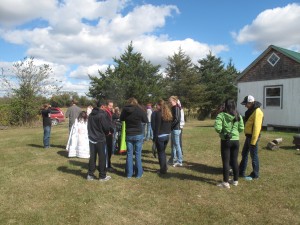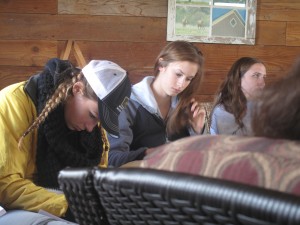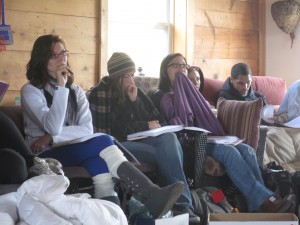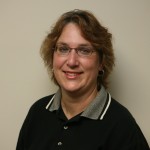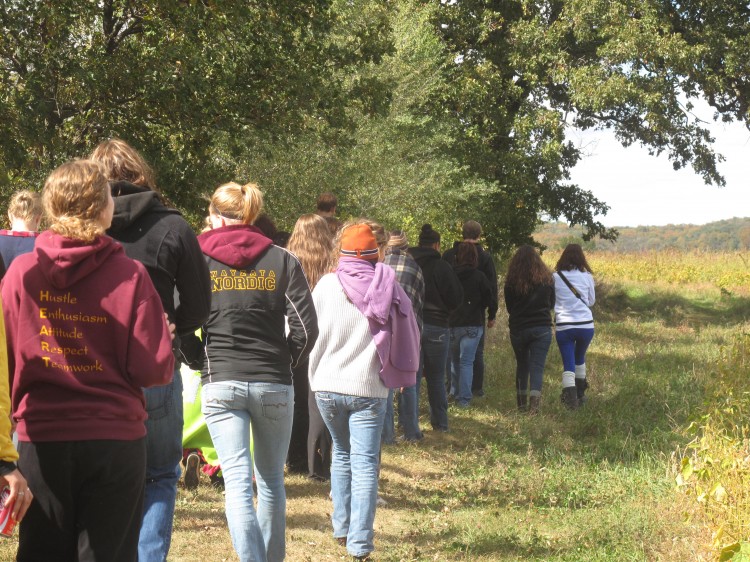
Reach Down as Well as Up – The Servant Leadership Program
Amy Pehrson
Douglas Woods, Minnesota author, wilderness guide, and musician has written a book titled, “The Things Trees Know.” It has become an inspiration piece for the re-creation of the Servant Leadership Program (SLP) at Gustavus Adolphus College. One of the quotes from this inspirational book that has captured our imagination in the SLP has been, “Reach down as well as up. No roots, no branches.” (Woods, 2005, p. 6). This quote has helped us shape this signature program of the Center for Servant Leadership.
Prior to its merger with the Center for Servant Leadership, the Center for Vocational Reflection housed the SLP for almost ten years. It has grown from a stipend program for summer camp counselors into a year-long leadership development program for any student. It is our hope that through this year-long process, student leaders are learning that in order to be servant-leaders they must address both the inner and outer landscapes of their lives.
It is also important to note that this new creation of the SLP is actually a combining of two distinct programs, the original SLP and the former Service Leadership Cohort from the Community Service Center. By combining these two programs, each has developed further and become stronger. Prior to the integration, the SLP focused on one’s inner landscape – one’s vocation and the emergence of one’s own sense of leadership. The Service Leadership Cohort’s focus was on the service that Gustavus students do in their communities through the ten on-going services programs sponsored by the Community Service Center. The objective of this group of upper-class students was to research and assess the outcomes of service. They also created benchmarks and objectives for each of the ten programs. The focus of this group was on the “outer landscapes,” of students’ experiences or ways in which they engage with the communities they are in. With this combination, not only did we bring the two different groups of students into one program where they can all have some of both of those types of experiences, but we also joined the program directors of each of these programs, Dave Newell from the Service Leadership Cohort and Amy Pehrson from the SLP, into a cohesive team whose focus is on both the inner and outer landscapes of some of the best and brightest of our Gustavus students.
With the way that the program is set up, we have three different parts of the SLP, which we have named Apprentices, Ambassadors, and Partners. The Apprentices are the students who are new to the ideas of vocation and servant leadership. These 24 Apprentices gather with the entire group of 36 once per month, and an additional time later in the month just as Apprentices. It is during the second meeting that we go deeper with these students to encourage them to wrestle with questions of purpose, service and leadership.
The Ambassadors are a smaller group of students, just six, who are charged with helping to infuse the campus with the language and concept of servant leadership. This is the newest aspect of the new SLP and so it has taken this group a bit longer to get up and running. They have been working on creating awareness of servant leadership, the Center itself, and what the SLP is. They continue to work on marketing hoping to use social media as a way to reach out to current Gustavus students, within both SLP and the general student population. The Ambassadors have also connected with our Residential Life department to design servant leadership workshops for next year that can be taken into various residential halls and used in partnership with residence staff and SLP Ambassadors.
Finally, the SLP Partners are similar to those students who were in the Service Leadership Cohort. They are the six students who do research, assessments, and make recommendations to the on-going service programs. They continue to listen to community partners, service program coordinators, and the volunteers themselves in order to continue to make improvements in the on-going service programs.
After a competitive application and selection process in the spring and summer, the program begins in the fall with an off-campus, overnight retreat. We begin this way, as many programs do, to build community, take time to engage with each other and the content, and to model to our students that finding dedicated time and space to participate deeply and fully is both important and necessary. Typically at this retreat, we debrief our strengths, using the Strengths Finder assessment, and sort out our values using a deck of values cards. This is a wonderful way in which our student leaders begin to look at who they are and where their roots come from.
Throughout the rest of the school year, the entire SLP group meets once per month. During these meeting times, our practice is to begin with five minutes of silence. Even though five minutes doesn’t seem like a long time, it allows everyone to set aside the rush of the day, the anxieties of the future, and to focus on being together. We either go into that silence or come out of it using inspirational words. Margaret Wheatley’s work has been a favorite of ours this year. Words such as “All that we do now must be done in a sacred manner and in celebration. For we are the ones we have been waiting for” (Wheatley, 2010, p. 125) have helped us to understand the great privileges we have to do this work, and that with that great privilege comes great responsibility.
The content of our time together focuses on the ten characteristics of servant leadership as identified by Larry Spears. We look for ways in which each of these characteristics (listening, healing, empathy, awareness, persuasion, stewardship, foresight, conceptualization, commitment to the growth of people, building community) help define who the student is becoming. We look for creative and engaging approaches for the students to understand these characteristics and share them in their circles. Some of the interesting exercises have included forms of deep listening (asking questions, but giving no answers), media fasts, and community scavenger hunts.
Throughout the times we have met, we also try to employ different avenues of instruction. We have used various Ted Talks, videos, guest speakers, and reading material. It is also important for us to allow time for personal reflection. After every time that we meet, we create journal prompts for the students to react to. Sometimes it is centered on the conversations we have had that evening, sometimes it is related to the articles we have read. Just as important as the retreat is for students to find the time and space to focus on what they are doing, journaling is also an important outlet. We hope that students use those prompts to have an honest conversation with themselves about the joys, struggles, new understandings and insights they discover throughout the month.
The Servant Leadership Program is designed to help students cultivate their own passions, desires, faith and meaning in ways that benefit the community and help to address the world’s deep needs. At the core of servant leadership is the idea of integrating life and work into a way of being that ignites one for positive change in the world (Spears, 1998). It is our intent that the Servant Leadership Program allows for students to dig deeper and become grounded in their core beliefs, and also to stretch their branches and be transformed into servant-leaders.
References:
Spears, L. C. (Ed.). (1998). The power of servant-leadership. San Francisco, CA: Berrett-Koehler Publishers, Inc.
Wheatley, M. J. (2010). Perseverance. San Francisco, CA: Berrett-Koehler Publishers, Inc.
Woods, D. (2005). The things trees know. Cambridge, MN: Adventure Publications, Inc.
About the Author
AMY PEHRSON is the Assistant Director of Vocation and Integrative Learning in the Center for Servant Leadership. Ms. Pehrson’s focus is on the leadership development of Gustavus students. This includes co-facilitating the Servant Leadership Program, co-directing the Gusties in On-going Leadership Development (G.O.L.D.) program, directing the Church Leadership Program, and as coordinator of the new Mentoring Program. Ms. Pehrson, a 1991 graduate of Gustavus, has served her alma mater her entire career. She lives on the Pehrson family farm outside of Saint Peter with her husband and three children.
